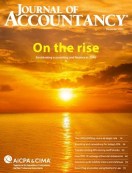- column
- TAX MATTERS
Sixth Circuit affirms application of split-dollar regulation
A life insurance policy’s premiums were held nondeductible by a dentist’s practice, and its increase in cash value was taxable income to the dentist.
Related
Why 2026 is another ‘big tax year’
IRS clarifies health savings account changes in H.R. 1 in new notice
PTEs need more notice of changes, more time to respond, AICPA says
The Sixth Circuit held, consistent with precedent, that a dentist and his practice were subject to the split-dollar regulation under Regs. Sec. 1.61-22. Thus the court held, affirming a district court decision, that the dentist was required to include in gross income increases in the cash value of a life insurance policy, and the practice could not deduct the premiums it paid on the policy.
Facts: Peter McGowan owned and operated a dentistry practice in the Toledo, Ohio, area. His practice was organized as a C corporation, and McGowan was the sole dentist and sole shareholder. His compensation consisted of a base salary as well as an annual bonus equal to the corporation’s remaining taxable income. McGowan purchased a whole-life insurance policy from Guardian Life Insurance Co. in his own name during his tenure as a dentist.
During the whole-life insurance policy’s coverage, McGowan entered into a new “tax-efficient alternative” coverage plan. On the recommendation of an associate of his health insurance adviser and an insurance agent, he entered into a plan to mirror the coverage provided by his Guardian life insurance plan, with nearly identical premiums and death benefits.
Under the new plan, the corporation compensated McGowan with life insurance through a “Benefits Trust Agreement,” which entailed the creation of two subtrusts: a “Death Benefit Trust” (DBT) and a “Restricted Property Trust” (RPT). The DBT acquired a different whole-life policy that covered McGowan. The corporation paid $37,222 annually to the DBT, which then paid the policy’s premium. The RPT operated as a similar conduit. The corporation paid the RPT up to $12,778 each year, which was then transferred to the DBT. The DBT used these payments to invest as paid-up additions to the policy, thereby increasing its cash value and death benefit. In exchange for the payments, the RPT received a security interest in the policy’s cash value.
McGowan renewed the plan every five years, with three potential outcomes. First, if McGowan died during the plan’s operation, his wife would receive the death benefit through the DBT after the RPT released its security interest, as she was McGowan’s designated beneficiary. Second, if the plan expired and McGowan chose not to renew it, the policy would be directly transferred to McGowan. Third, if the corporation failed to contribute the premium to the DBT annually, the DBT would collect the cash value of the policy by surrendering it. After surrender, the DBT would transfer the cash to the RPT to satisfy its security interest, and the RPT would donate the cash value to a charity McGowan had selected, the Toledo Zoo.
As a result of the plan, McGowan and the corporation realized tax advantages. The only taxable income McGowan reported on his tax return was the $12,778 contribution to the RPT, opting not to include the value of the policy’s death benefit or its accumulated cash value. The corporation took $50,000 annually in deductions for payments to the DBT and RPT.
McGowan executed the plan in 2011 and continued it through 2015, with the intention to extend it. McGowan attempted to renew the plan but failed to do so, as he missed the renewal deadline. This error meant that ownership of the second policy was transferred directly to McGowan in 2016. Upon the transfer, McGowan reported taxable income of the cash value of the policy less the annual RPT contributions that he had already reported, totaling $115,227 of taxable income.
Following the transfer, the IRS audited both McGowan and the corporation for tax years 2014 and 2015. The Service concluded that McGowan should have been recognizing the cash value accumulation of the policy rather than solely the RPT contributions. In addition, the audit found that the corporation should not be permitted any deduction for its payments to the DBT ($37,222 per year). The IRS did not take issue with the corporation’s annual $12,778 RPT-related deductions. As such, McGowan was assessed additional taxes and penalties of $65,590, and the corporation was assessed $37,165, covering tax years 2014 and 2015 for both.
Following the close of the audit, McGowan filed suit in district court. The court granted the IRS summary judgment and denied McGowan’s motion to reconsider (McGowan, 694 F. Supp. 3d 992, 1005 (N.D. Ohio 2023); McGowan, No. 19 CV 1073 (N.D. Ohio 3/13/24)). McGowan appealed the decision to the Sixth Circuit.
Issues: The core issue before the court was the applicability of Regs. Sec. 1.61-22, the split-dollar regulation. This regulation applies where an employer pays employee life insurance premiums, with the employee and employer often sharing in the benefits of the policy (see Rev. Rul. 64-328). Under Regs. Secs. 1.61-22(b)(1)–(2), general, compensatory, and shareholder life insurance plans each trigger similar tax consequences. McGowan’s arrangement was compensatory, the court stated. Such plans include “[a]ny arrangement between an owner and a non-owner of a life insurance contract” in which the arrangement is connected with “the performance of services and is not part of a group-term life insurance plan” and “the employer or service recipient pays, directly or indirectly, all or any portion of the premiums” (Regs. Secs. 1.61-22(b)(2)(ii)(A)–(B)). In addition to these requirements, Regs. Sec. 1.61-22(b)(2)(ii)(C) also requires that either of the following conditions is met:
- The beneficiary of all or any portion of the death benefit is designated by the employee or service provider or is any person whom the employee or service provider would reasonably be expected to designate as the beneficiary; or
- The employee or service provider has any interest in the policy cash value of the life insurance contract.
Provided that a compensatory plan satisfies these items, McGowan was required to “recognize the full value of the Plan’s economic benefits (minus any consideration he paid to the [corporation] for those benefits),” the court stated. In addition, the corporation would not be able to deduct payments of premiums.
McGowan first contended that he was not subject to the split-dollar regulation. He argued that the corporation was not an owner of the policy since the DBT was its legal owner, with an independent trustee, making the arrangement between nonowners rather than an owner and nonowner. The court stated, however, that under the split-dollar regulation, “an employer ‘is treated as the owner of the life insurance contract if the owner’ of that policy is ‘[a] welfare benefit fund within the meaning of [Sec.] 419(e)(1)'” (Regs. Sec. 1.61-22(c)(1)(iii)(C)). Under Sec. 419(e)(1), the DBT clearly met the standard of being a welfare benefit fund, as it was part of an employer’s plan and provided welfare benefits to employees, the court stated. Further, McGowan explicitly described the DBT as a welfare benefit fund in the district court case.
The court also rejected McGowan’s argument that “[f]orm is ‘substance’ when it comes to law” and that the court’s interpretation “improperly conflates the substance of the Plan over its form” (Summa Holdings, Inc., 848 F.3d 779, 782 (6th Cir. 2017)). In doing so, the court noted that it assesses form and substance according to regulations, and the split-dollar regulation “treat[s] a welfare benefit fund as synonymous with the employer.”
McGowan’s second contention was that the arrangement successfully circumvented the split-dollar regulation’s conditions under Regs. Sec. 1.61-22(b)(2)(ii)(C), which specifically states that a plan is subject to the split-dollar regulation if either of its two requirements is met. Because McGowan designated his wife as the beneficiary of the entire death benefit, subclause (C)(1) was expressly met, the court held. This was despite the fact that the plan designated the Toledo Zoo as a beneficiary if the corporation failed to contribute the premiums, as the charity’s interest was the cash value of the plan rather than the death benefit described in the split-dollar regulation, the court held. Also, even though the DBT was technically the first recipient of the death benefit, it was required to pay the benefit to McGowan’s wife upon his death, creating an obligation.
Next, McGowan posited that even if he were subject to the split-dollar regulation, he reported the correct amount of taxable income during the 2014 and 2015 tax years. Specifically, McGowan took issue with Regs. Sec. 1.61-22(d)(2)(ii), which provides that taxable income includes “the amount of policy cash value to which the non-owner has current access within the meaning of paragraph (d)(4)(ii).” McGowan argued that because the arrangement provided for a “forced donation to charity,” he did not have “current access” to the policy’s cash value. However, the split-dollar regulation explicitly defines “current access” to include “future rights,” the court noted. The court concluded that the plan’s potential donation to charity did not constitute a “substantial risk of forfeiture” under Sec. 83(a)(1), as McGowan argued, but rather a current or future right, since McGowan selected the beneficiary charity, the Toledo Zoo, as opposed to a charity “outside of his purview.”
Finally, McGowan cited Loper Bright Enterprises v. Raimondo, 603 U.S. 369 (2024), which overruled the prior doctrine of deference to administrative rulemaking under Chevron U.S.A. Inc. v. Natural Resources Defense Council, Inc., 467 U.S. 837 (1984), arguing that if the district court had applied the Loper Bright standard or correctly applied Chevron deference, it would have concluded that the split-dollar regulation went beyond congressional intent. However, the Sixth Circuit determined that since McGowan had already challenged the regulation in district court under Chevron, he was unable to do so on appeal with Loper Bright.
McGowan also claimed that the split-dollar regulation improperly limited the corporation from taking deductions, which again McGowan cast as an issue pertaining to the legitimacy of the regulation under Loper Bright. However, Sec. 419(a) “prohibits deductions for ‘[c]ontributions paid or accrued by an employer to a welfare benefit fund’ unless ‘they would otherwise be deductible,'” the court noted. The Sixth Circuit determined that the premiums were not “ordinary” and “necessary” trade or business expenses under Sec. 162(a) because they “served merely to advance McGowan’s personal goal of leaving a beneficiary of his choice (who need not be related to the [corporation]) over $2 million, no strings attached, in an attempted tax-efficient vehicle.” The only benefit to the company was a tax-deductible contribution. However, as the court stated, “tax avoidance alone does not suffice for a ‘trade or business’ expense under [Sec.] 162(a),” and thus the deductions by the company for the premiums did not qualify for a Sec. 162(a) deduction.
Holding: The Sixth Circuit affirmed the district court’s decision, holding that McGowan’s arrangement was subject to the split-dollar regulation. Accordingly, McGowan should have included the full value of the policy’s economic benefits in his taxable income each year, and the corporation was not entitled to any deduction for its premium payments.
- McGowan, No. 24-3228 (6th Cir. 2025)
— Thomas Godwin, CPA, CGMA, Ph.D., and John McKinley, CPA, CGMA, J.D., LL.M., are both professors of the practice in accounting and taxation in the SC Johnson College of Business at Cornell University. To comment on this column, contact Paul Bonner, the JofA‘s tax editor.



















